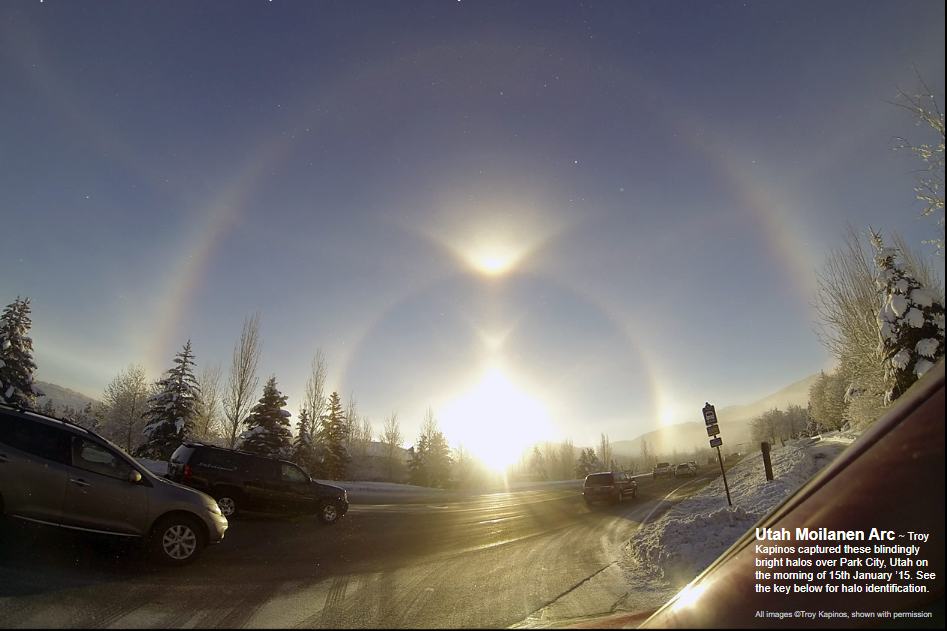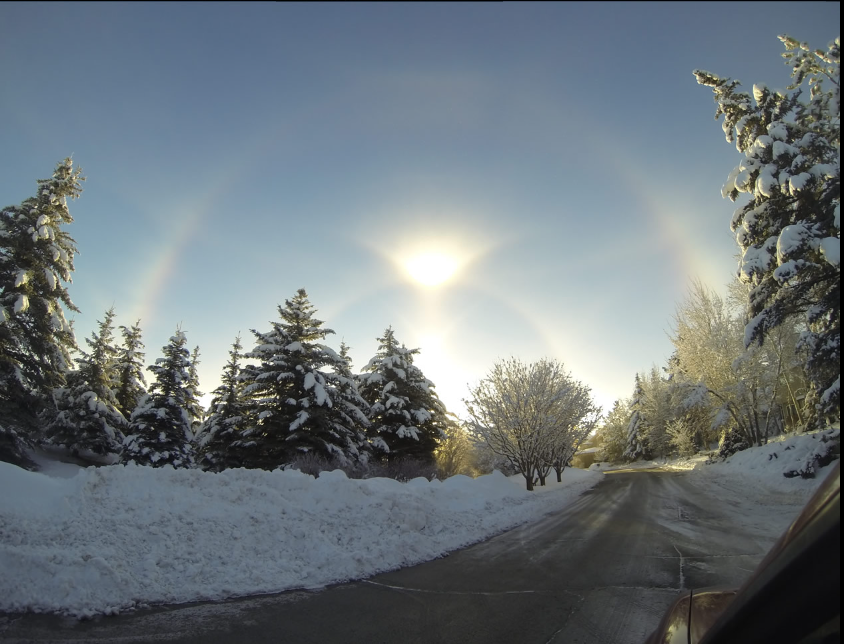Utah Moilanen Arc - OPOD
Utah Moilanen Arc: A Stunning Atmospheric Optics Phenomenon
Utah Moilanen Arc, captured by Troy Kapinos in Park City, Utah on January 15th, 2015, is a mesmerizing display of blindingly bright halos. These halos, formed by hexagonal prisms in the atmosphere, create an awe-inspiring spectacle that rivals even the most extraordinary Antarctic halos. In this article, we will delve into the fascinating details of the Utah Moilanen Arc and explore the various halo formations that contribute to its breathtaking beauty.
The Influence of Ski Resort Snow Blowers
One of the contributing factors to the brilliance of the Utah Moilanen Arc is the presence of a nearby ski resort. Ski-slope snow blowers used in the resort release bacteria that act as nuclei for snow crystal formation. While most of these nuclei fall directly onto the slopes, some get carried far downwind. These bacteria nuclei play a crucial role in promoting the gradual growth of small hexagonal prisms, which are responsible for generating the bright and rare arcs observed in the Utah Moilanen display.
The Enigmatic Moilanen Arc
One of the most intriguing aspects of the Utah Moilanen Arc is the presence of a bright and almost complete Moilanen arc between the sun and the upper tangent. The origin of this arc remains a mystery, with researchers yet to provide a definitive explanation for its formation. This enigmatic phenomenon adds an element of wonder to an already extraordinary atmospheric optics display.
The Upper Tangent Arc and its Significance
The upper tangent arc is a prominent feature of the Utah Moilanen Arc. This arc, which rivals the sun in brightness, indicates that the air is filled with horizontal column crystals. These crystals not only generate outer colorful supralateral and infralateral arcs but also produce the remarkably prominent Wegener arc. The presence of these crystals adds to the overall brilliance and complexity of the Utah Moilanen display.
Parry Crystals and Helic Arcs
In addition to the hexagonal prisms and column crystals, the Utah Moilanen Arc also showcases the presence of Parry crystals. The upper Parry arc, although somewhat obscured by the glare of the tangent arc, can still be observed. Moreover, helic arcs coursing from the sun provide further evidence of the presence of these Parry crystals. These crystal formations contribute to the intricate patterns and phenomena observed within the Utah Moilanen display.
The 22° Halo and Traces of the 46°
Among the diverse array of halo formations in the Utah Moilanen Arc, randomly oriented crystals give rise to the 22° halo, a circular halo centered around the sun. Additionally, traces of the 46° halo can also be detected. These halo formations, although less prominent compared to others, contribute to the overall complexity and beauty of the Utah Moilanen display.
A Natural Wonder That Continues to Captivate
The Utah Moilanen Arc serves as a testament to the captivating wonders of atmospheric optics. Its unique combination of various halo formations, including hexagonal prisms, column crystals, Parry crystals, and enigmatic Moilanen arcs, creates a spectacle that astounds and mesmerizes all who witness it. Despite ongoing research and investigation, some aspects of this phenomenon remain shrouded in mystery, adding to its allure and mystique. The Utah Moilanen Arc stands as a reminder of the intricate and awe-inspiring phenomena that occur within our atmosphere, constantly reminding us of the beauty and complexity of the natural world.

Utah Moilanen Arc ~ Troy Kapinos captured these blindingly bright halos over Park City, Utah on the morning of 15th January ’15. See the key below for halo identification.
All images ©Troy Kapinos, shown with permission

A ski resort is nearby. Many ski-slope snow blowers spray out bacteria to nucleate their snow crystals. The snow falls directly onto the slopes but some bacteria nuclei get carried far downwind where they are very effective in also promoting the gradual growth of the small hexagonal prisms that produce halos. These crystals are almost perfect and so produce bright and often very rare arcs. The displays can rival the very best of Antarctic halos. The crystals helped in their growth by enzyme nucleation are still natural and the halos still stupendous!
The upper tangent arc rivals the sun and signals that the air is full of horizontal column crystals. these also generate the outer colourful supralateral and infralateral arcs. They also produced the amazingly prominent Wegener arc.
Some Parry crystals were about too. The upper Parry arc is almost lost in the glare of the tangent arc but the helic arcs coursing from the sun reveal the crystals' presence.
Randomly oriented crystals of some sort made the 22° halo and the and traces of the 46°.
Mystery crystals give a bright and almost complete Moilanen arc between the sun and the upper tangent. We have still not explained its origin.

Note: this article has been automatically converted from the old site and may not appear as intended. You can find the original article here.
Reference Atmospheric Optics
If you use any of the definitions, information, or data presented on Atmospheric Optics, please copy the link or reference below to properly credit us as the reference source. Thank you!
-
<a href="https://atoptics.co.uk/blog/utah-moilanen-arc-opod/">Utah Moilanen Arc - OPOD</a>
-
"Utah Moilanen Arc - OPOD". Atmospheric Optics. Accessed on November 15, 2024. https://atoptics.co.uk/blog/utah-moilanen-arc-opod/.
-
"Utah Moilanen Arc - OPOD". Atmospheric Optics, https://atoptics.co.uk/blog/utah-moilanen-arc-opod/. Accessed 15 November, 2024
-
Utah Moilanen Arc - OPOD. Atmospheric Optics. Retrieved from https://atoptics.co.uk/blog/utah-moilanen-arc-opod/.